|

Maya - Mexico
Mud men
from the Popol Vuh
|
The Popol-Vuh, the
sacred book of the Maya, contains
within its creation story a tale of the destruction of the
first beings by a flood. This flood differs from others in
that it is not a punishment, but rather a remedy for a
faulty creation. The Feathered Serpent first created man
from mud. These creatures were a failure; they couldn't see,
they dissolved when it rained, etc. So the god broke them up
and tried again.
"This time he made men out of wood. They were better than
the mud-men. They could walk and talk; they had many
children, built many houses, but they had no minds nor souls
nor hearts. The Feathered Serpent was disappointed with what
he had created, so he sent a great flood to cleanse the
earth of his mistake. |
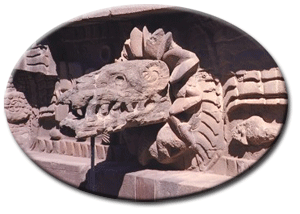 |
Myth 2
In the beginning was only Tepeu and Gucumatz
(Feathered
Serpent). These two sat together and thought, and whatever
they thought came into being. They thought earth, and there
it was. They thought mountains, and so there were. They
thought trees, and sky, and animals etc, and each came into
being. But none of these things could praise them, so they
formed more advanced beings of clay. But these beings fell
apart when they got wet, so they made beings out of wood,
but they proved unsatisfactory and caused trouble on the
earth. The gods sent a great flood to wipe out these beings,
so that they could start over. With the help of Mountain
Lion, Coyote, Parrot, and Crow they fashioned four new
beings. These four beings performed well and are the
ancestors of the Quich.
Pueblo
Somewhere to the
north the first humans climbed out of a hole in the earth
into the sunlight. The underground place from which they
came is called Sipapu. This is a sacred place.
The Great
Spirit protected them as they wandered the land. At long
last they came upon a place they knew was meant for them.
They settled there.
Nuu-chal-nuth
|
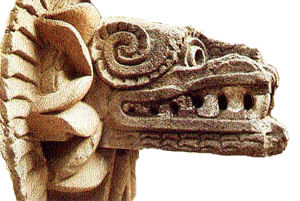 |
The great spirit
Quatz created woman, whom he left alone in the dark forest.
The woman lamented day and night, until Quatz took pity and
appeared to her in a canoe of copper, in which many handsome
young men were rowing. One of the rowers told her it was the
great spirit who was supplying her with the companionship
she craved. At these words she cried the more, and as the
tears trickled down, they fell to the ground. Quatz
commanded her to look, and she saw with amazement a tiny
child, a boy, entirely formed. Her firstborn son became the
ancestor of the taises(?), while from her other sons the
common people are descended. |
Tiahuanaco
In the
beginning, Lord Kon Tiki Viracocha, prince and creator of
all things, emerged from the void and created the earth and
the heavens. Then he created animals and a
race of giants
(who lived in eternal darkness as he had neglected to create
a source of light). These beings enraged the Lord, and he
turned them into stone.
|
Then he flooded the earth till all
was under water, and all life extinguished. In a new start,
he created the sun, moon, and stars. Now he created new
birds and animals. Again he decided to form human beings:
these he fashioned from stone. Some he painted with long
hair, some with short hair; some women he painted as
pregnant, some as caring for the babies fashioned beside
them; and on each figure he painted the clothes they would
continue to wear.
Finally he divided the stone figures into
groups, giving each group its own language, its own food to
grow, and its own songs to sing. Then he buried all the
figures in the earth to await his command that would bring
them to life. Viracocha then summoned his helpers and told
them to go forth on the earth in different directions to
prepare places for the new humans to occupy. |
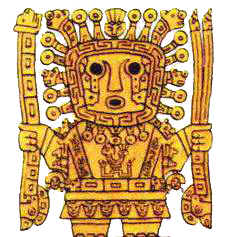 |
Viracocha then
traveled the land, calling each group into life as he passed
the land they were to populate, whereupon he taught them how
to live on the land selected for them. (There is a
continuance of this story that has Viracocha and his
companions, when finished with their teachings, walking on
the waves of the ocean as they disappear toward the setting
sun. Viracocha means "foam of the sea".)
|
Tiahuanaco, located on Lake Titicaca in Bolivia, was a major
religious center of the Huari-Tiahuanaco empire. During the
Middle Horizon (AD 600-1000), the Huari military
organization dominated the Peruvian Andes, and eventually
linked up with the formidable priestly apparatus at
Tiahuanaco to create a ╩powerful theocratic state.
The symbolic relief carvings on the Gateway of the Sun at
Tiahuanaco, often strikingly well-preserved in slabs of
volcanic andesite, were first reported in detail by Ephriam
G. Squier in his 1877 book, ╩Incidents of Travel and
Exploration in the Land of the Incas.
Squier describes the tiers of winged condor-headed and
human-headed figures kneeling toward the central sun god
figure "as if in adoration, each one holds before him a
staff or sceptre..." ╩These winged figures represent the
heads of condors, tigers, and serpents. The central figure
in the Sun Gateway, holding a pair of staffs, is probably
linked to the much earlier Chavin Staff God (from ca.
800-300 BC).
Squier also notes that the islands of Lake Titicaca were
traditionally thought to have produced the founders of the
Inca Empire. This appears to be upheld by modern
archaeology, which shows that during the Huari-Tiahauanaco
period, centralized state organization occurred with
regional storehouses, roads, and redistribution of resources
and local populations, all preceding the much better
documented Inca empire by hundreds of years. |

Winged figures on the side of the Gateway of the Sun at
Tiahuanaco |
Aztec
Myth 1
|
Quetzalcoatl, the light one, and
Tezcatlipoca, the dark one,
looked down from their place in the sky and saw only water
below.
A gigantic goddess floated upon the waters, eating
everything with her many mouths.
The two gods saw that
whatever they created was eaten by this monster. They knew
they must stop her, so they transformed themselves into two
huge serpents and descended into the water.
One of them
grabbed the goddess by the arms while the other grabbed her
around the legs, and before she could resist they pulled
until she broke apart. Her head and shoulders became the
earth and the lower part of her body the sky.
The other gods
were angry at what the two had done and decided, as
compensation for her dismemberment, to allow her to provide
the necessities for people to survive; so from her hair they
created trees, grass, and flowers; caves, fountains, and
wells from her eyes; rivers from her mouth; hills and
valleys from her nose; and mountains from her shoulders.
Still the goddess was often unhappy and the people could
hear her crying in the night.
They knew she wept because of
her thirst for human blood, and that she would not provide
food from the soil until she drank.
So the gift of human
hearts is given her. She who provides sustenance for human
lives demands human lives for her own sustenance. So it has
always been; so it will ever be. |
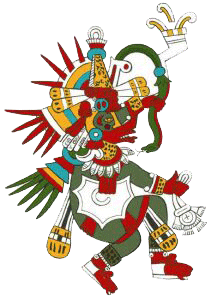
Quetzalcoatl |
|
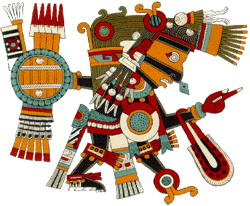
Tezcatlipoca |
Myth 2
The mother of the Aztec creation story was called "Coatlique",
the Lady of the Skirt of Snakes. She was created in the
image of the unknown, decorated with skulls, snakes, and
lacerated hands. There are no cracks in her body and she is
a perfect monolith (a totality of intensity and
self-containment, yet her features were square and
decapitated).
Coatlique was first impregnated by an obsidian knife and
gave birth to Coyolxanuhqui, goddess of the moon, and to a
group of male offspring, who became the stars. Then one day
Coatlique found a ball of feathers, which she tucked into
her bosom. When she looked for it later, it was gone, at
which time she realized that she was again pregnant. Her
children, the moon and stars did not believe her story.
Ashamed of their mother, they resolved to kill her. A
goddess could only give birth once, to the original litter
of divinity and no more. During the time that they were
plotting her demise, Coatlicue gave birth to the fiery god
of war, Huitzilopochtli. With the help of a fire serpent, he
destroyed his brothers and sister, murdering them in a rage.
He beheaded Coyolxauhqui and threw her body into a deep
gorge in a mountain, where it lies dismembered forever.
The natural cosmos of the Indians was born of catastrophe.
The heavens literally crumbled to pieces. The earth mother
fell and was fertilized, while her children were torn apart
by fratricide and them scattered and disjointed throughout
the universe.
Ometecuhlti and his wife Omecihuatl
created all life in the
world. Their children were:
-
Xipe
Totec - The Lord of the Springtime
-
Huitzilopochtli - the Sun god
-
Quetzalcoatl - the Plumed Serpent
-
Tezcatlipoca - the god of Night and Sorcery
-
Coatlicue - She of the Serpent Skirt
|